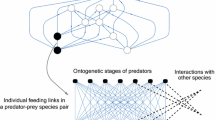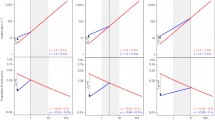Summary
The forage ratio and Ivlev's electivity index are common measures to quantify food selection but the values of both indices depend not only on the extent of selection but also on the relative abundances of the food types in the environment. They are therefore useless when food types with different relative abundances are compared, or when the relation between selection and relative abundance is studied. Modified versions of both indices are proposed which are based directly on the rates of decrement (mortality) of the food due to feeding, and are independent of the relative abundance.
Similar content being viewed by others
References
Edmondson, W. T., Winberg, G. G. (eds.): A manual on methods for the assessment of secondary productivity in fresh waters. IBP Handbook No. 17. Oxford: Blackwell 1971
Ivlev, V. S.: Experimental ecology of the feeding of fishes. New Haven: Yale Univ. Press 1961
Author information
Authors and Affiliations
Rights and permissions
About this article
Cite this article
Jacobs, J. Quantitative measurement of food selection. Oecologia 14, 413–417 (1974). https://doi.org/10.1007/BF00384581
Received:
Issue Date:
DOI: https://doi.org/10.1007/BF00384581




